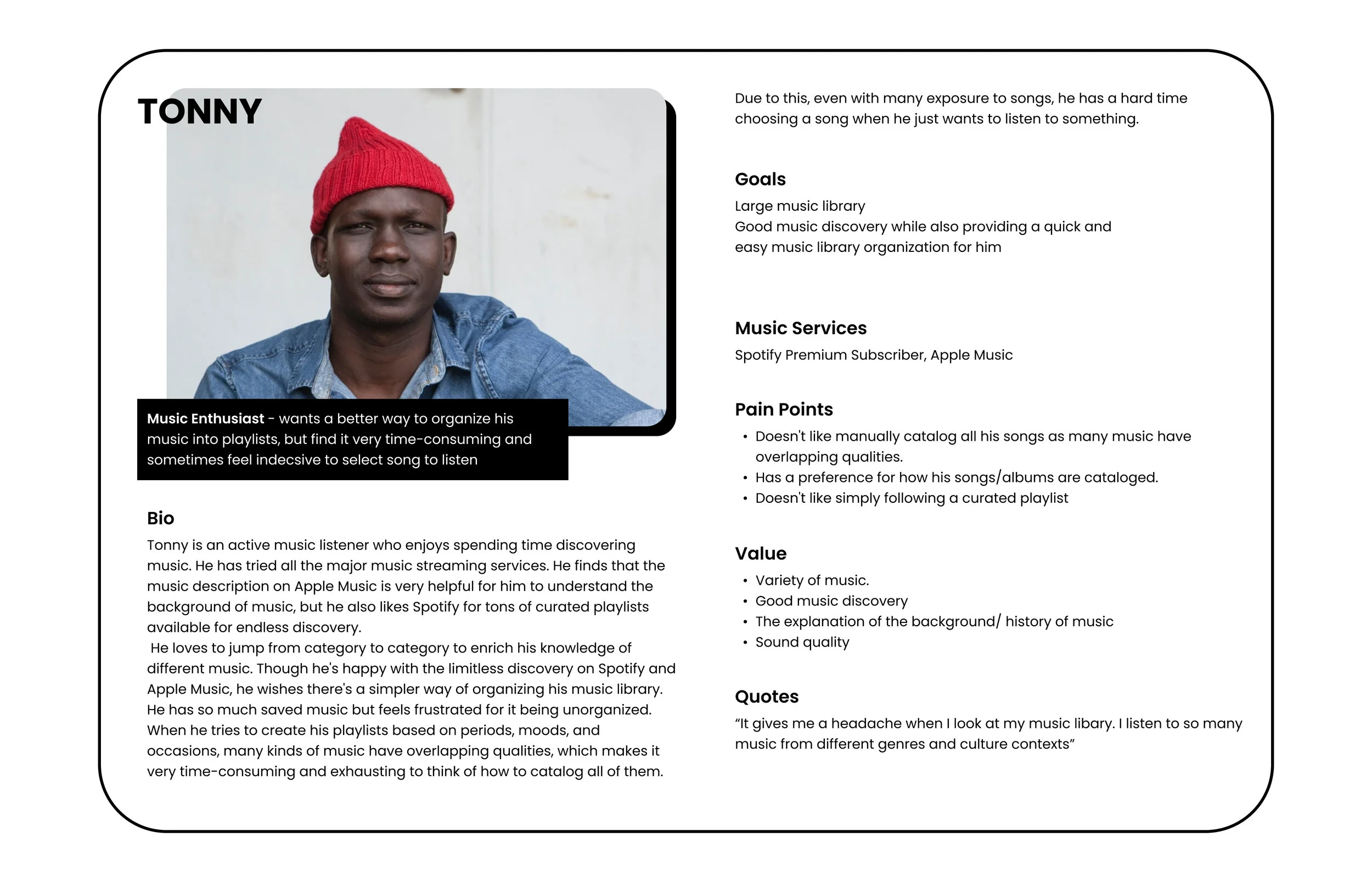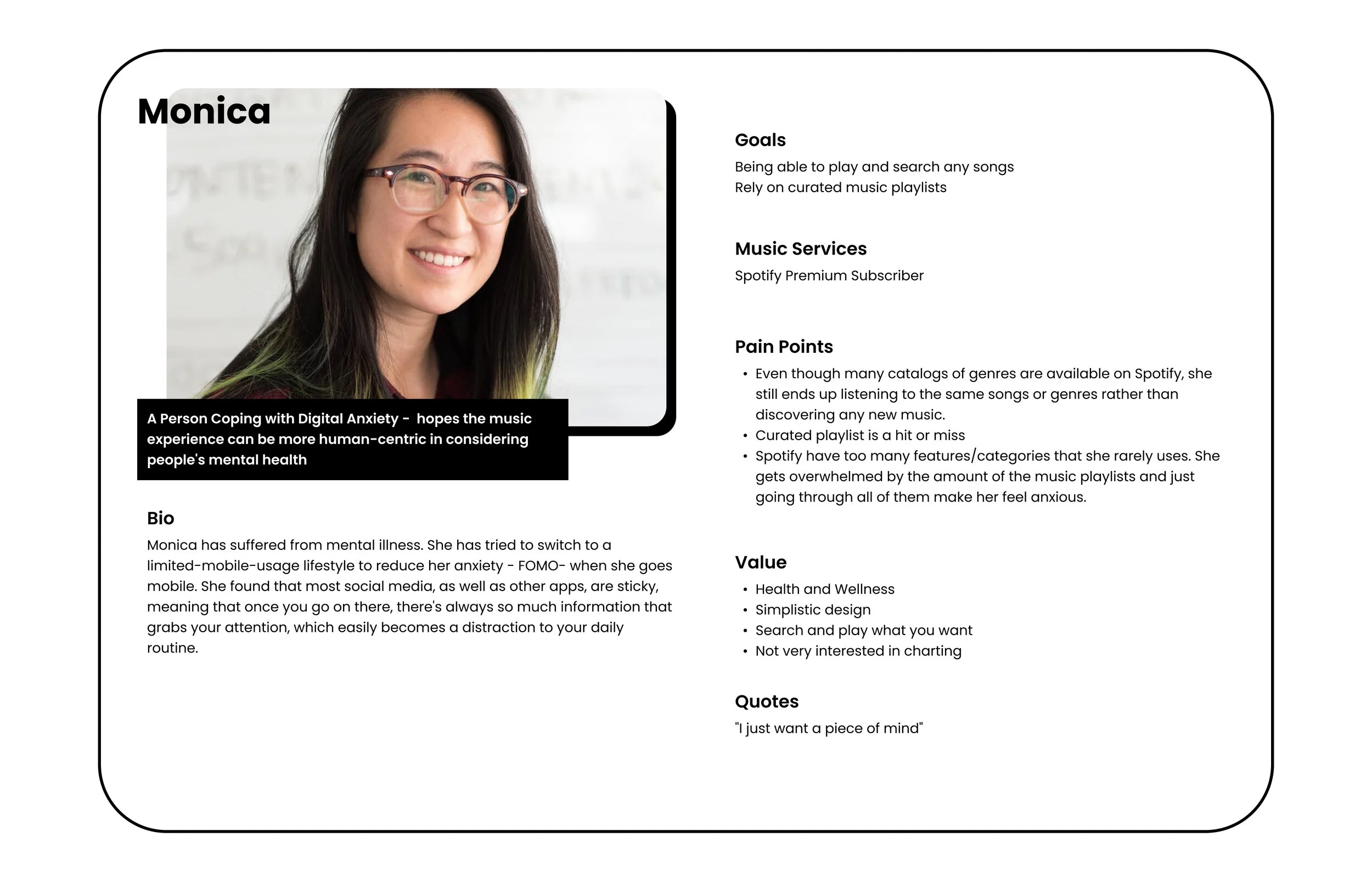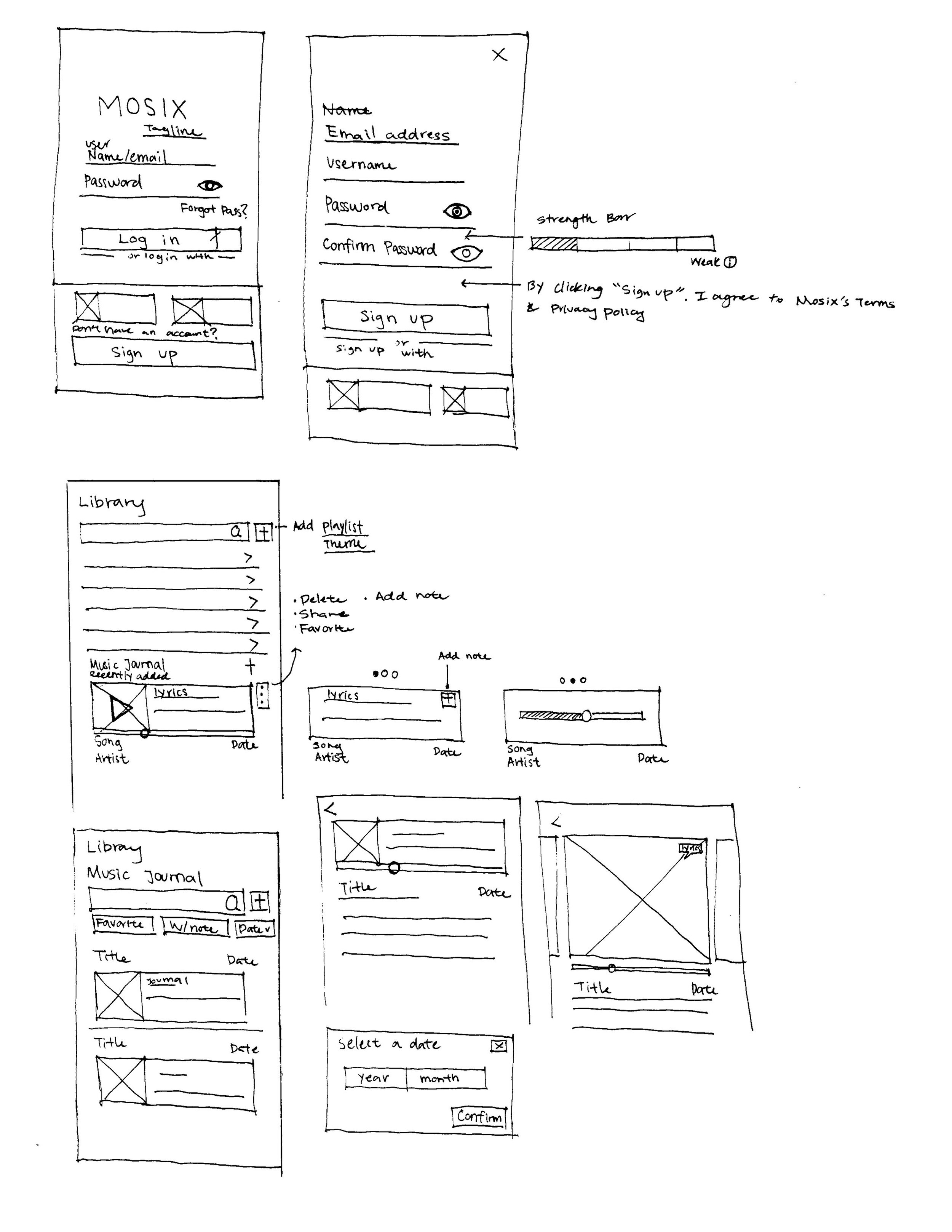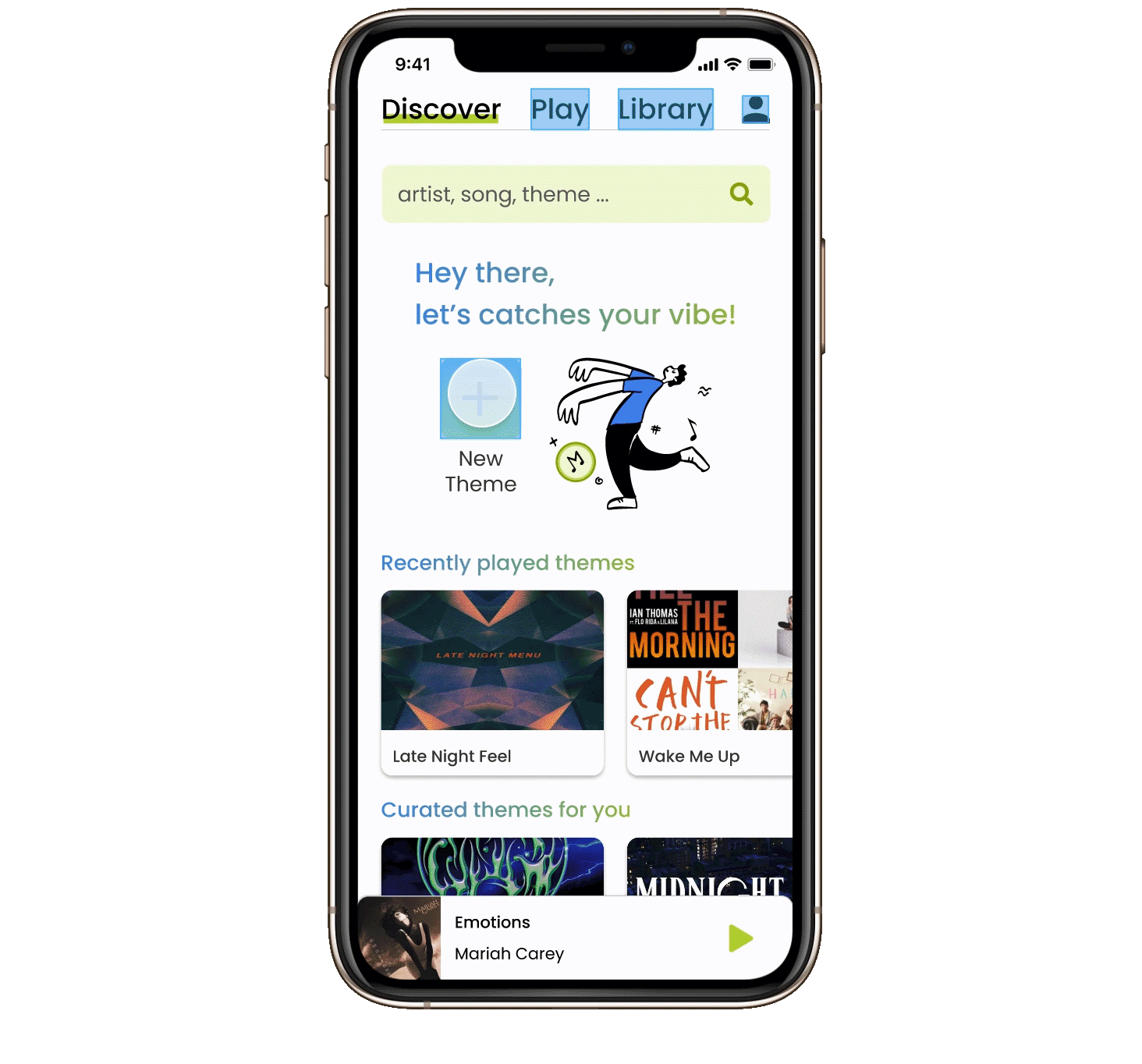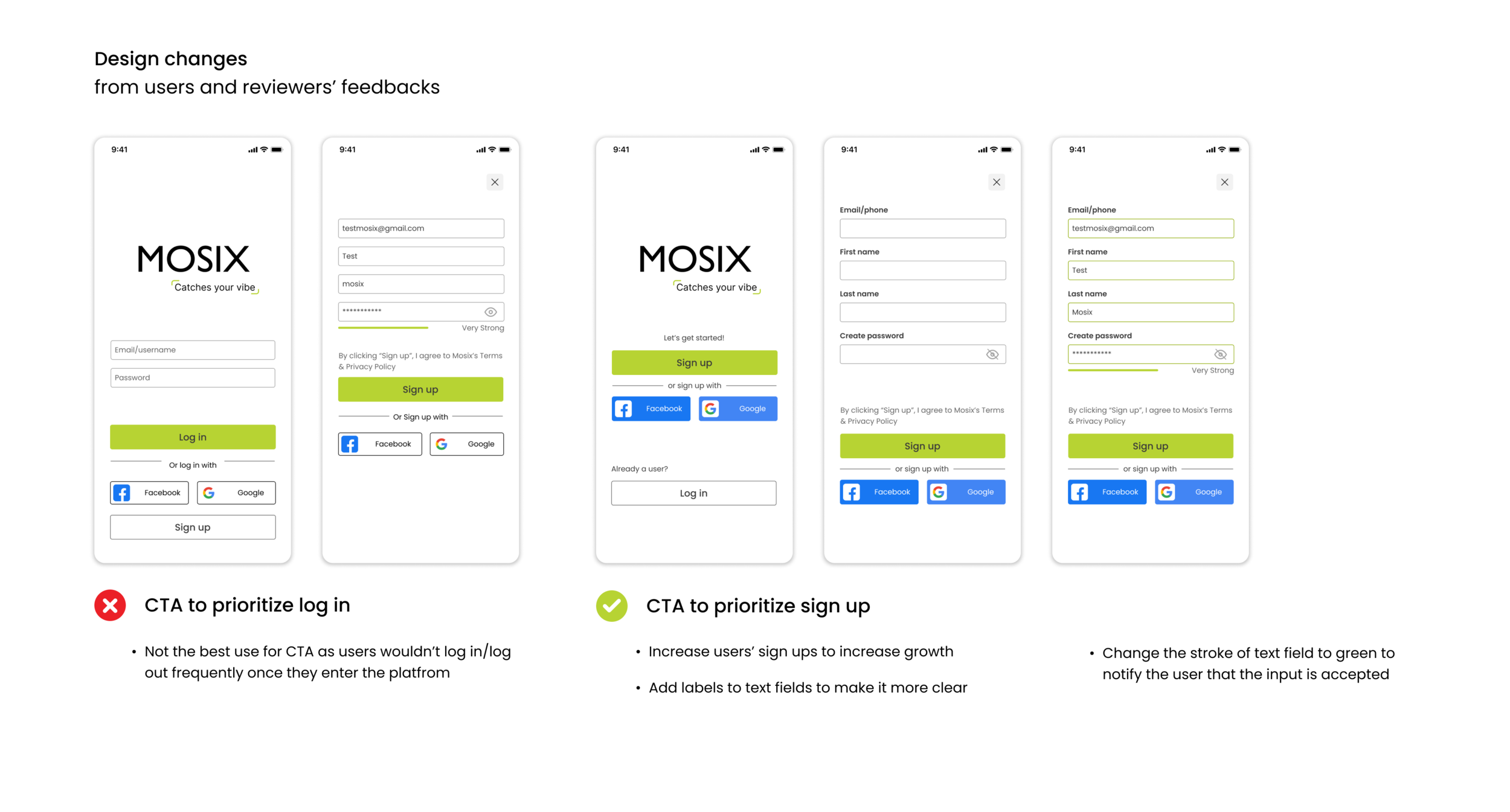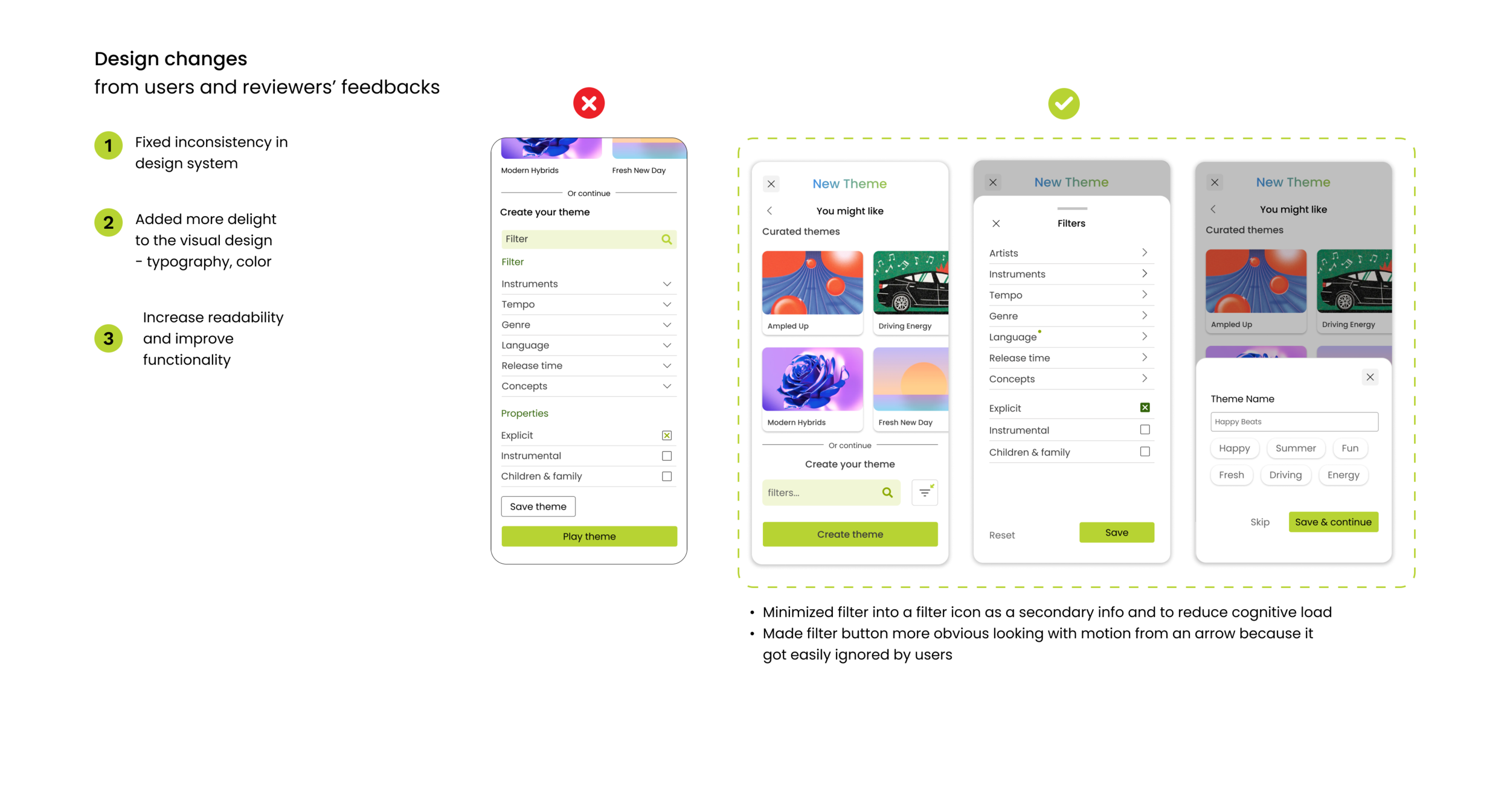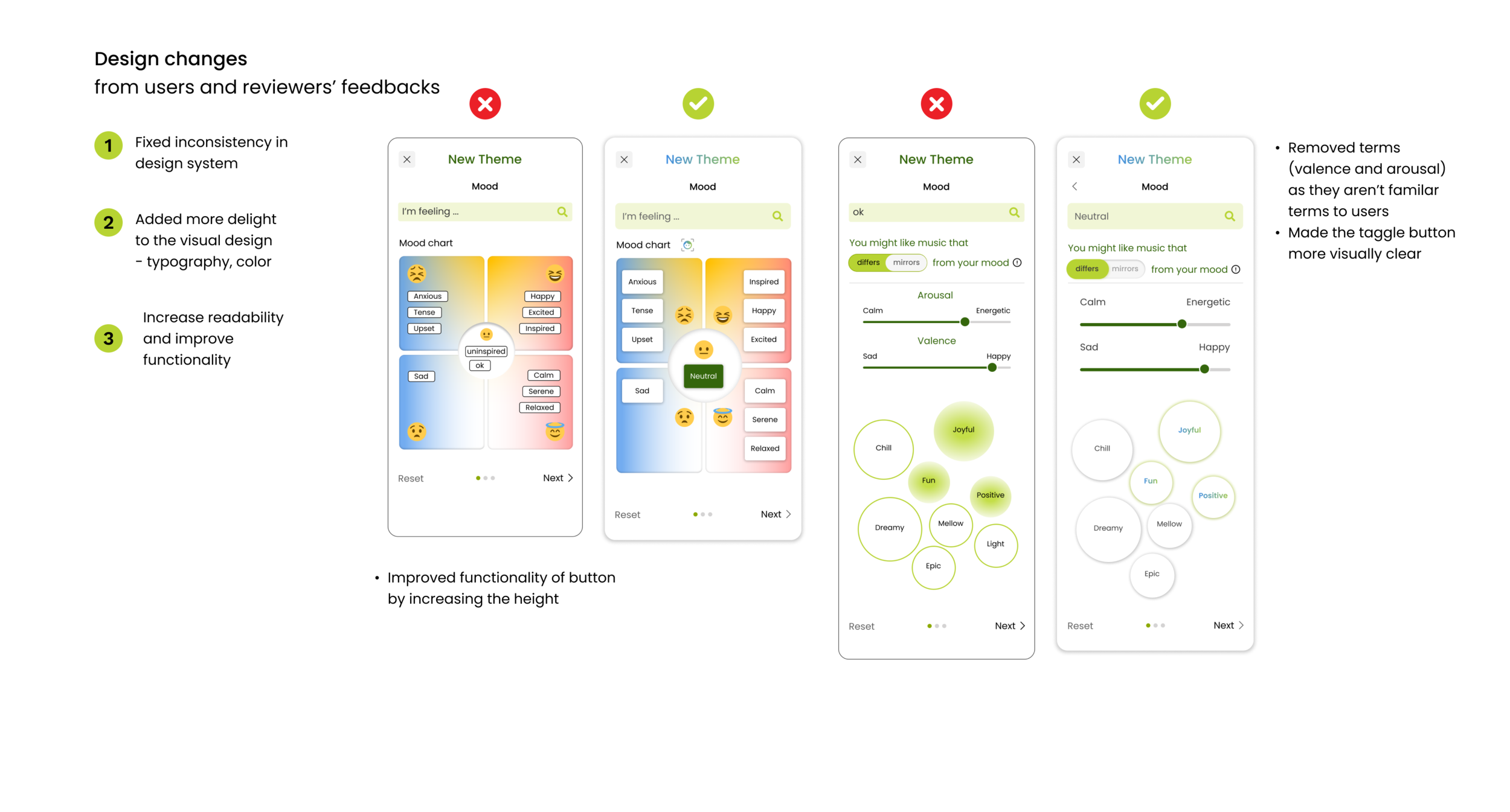Personalize the experience of discovering and listening to music
Skills
User research, user journey, empathy map, persona, information architecture, wireframe, prototype
Tools
Figma, Invision, OmniGraffle
Timeline
First draft - 2 months, Redesign - 2 months
/ Music captures a thought, an experience, a feeling, and or a memory of an artist; but only with a deep analysis of musical elements, an app would recommend the right catalogs of songs that align with an artist’s vision to a listener. /
1. Understand the Problem
Does having an “unlimited” source of music give users the music experience they want?
Music isn't about who has the most on their platform anymore, but how well you can find music, get recommendations, and discover new exciting artists and playlists.
Painpoints from current music streaming services
Time-consuming
It takes a long time to manually create playlists and keep an organized music library
Spotify has 70+ million tracks and 4+ billion playlists
The effort users spend browsing in a large music catalog can be too much
Ineffective Recommendation & Categorization
Heavy focuses are placed on charting, genre, a preconceived social concept, and popularity.
Fail to address user needs as these are no longer the best practical tools for guiding users to discover/listen to music
Curated playlists, even for the mood, are purely based on what the curators think the listeners are going to like and what they see in the data, which won’t always align with the energy of the user.
What users really want
Effective music recommendation that aligns with their
+
Environment Mood
Top important attributes of listening to music
A Gap in the Market
Streaming services’ objectives are not always aligned with those of listeners. So there remains a gap in existing music services on effective music recommendation that fits the right moods and/ environments.
On the contrary, Spotify's “personalized” recommendation leans toward popularity from online discussion and “similar” music based on “similar” user groups. This is because the top two models used by Spotify aren’t based on actually understanding music
Hypothesis
Using an algorithm focused on understanding music, Mosix uses a machine-learning algorithm(natural language processing, sentimental analysis, audio analysis) that analyzes musical components like rhythm, harmony, timbre, etc. in correlation with moods, and distills these into categories of moods and activities.
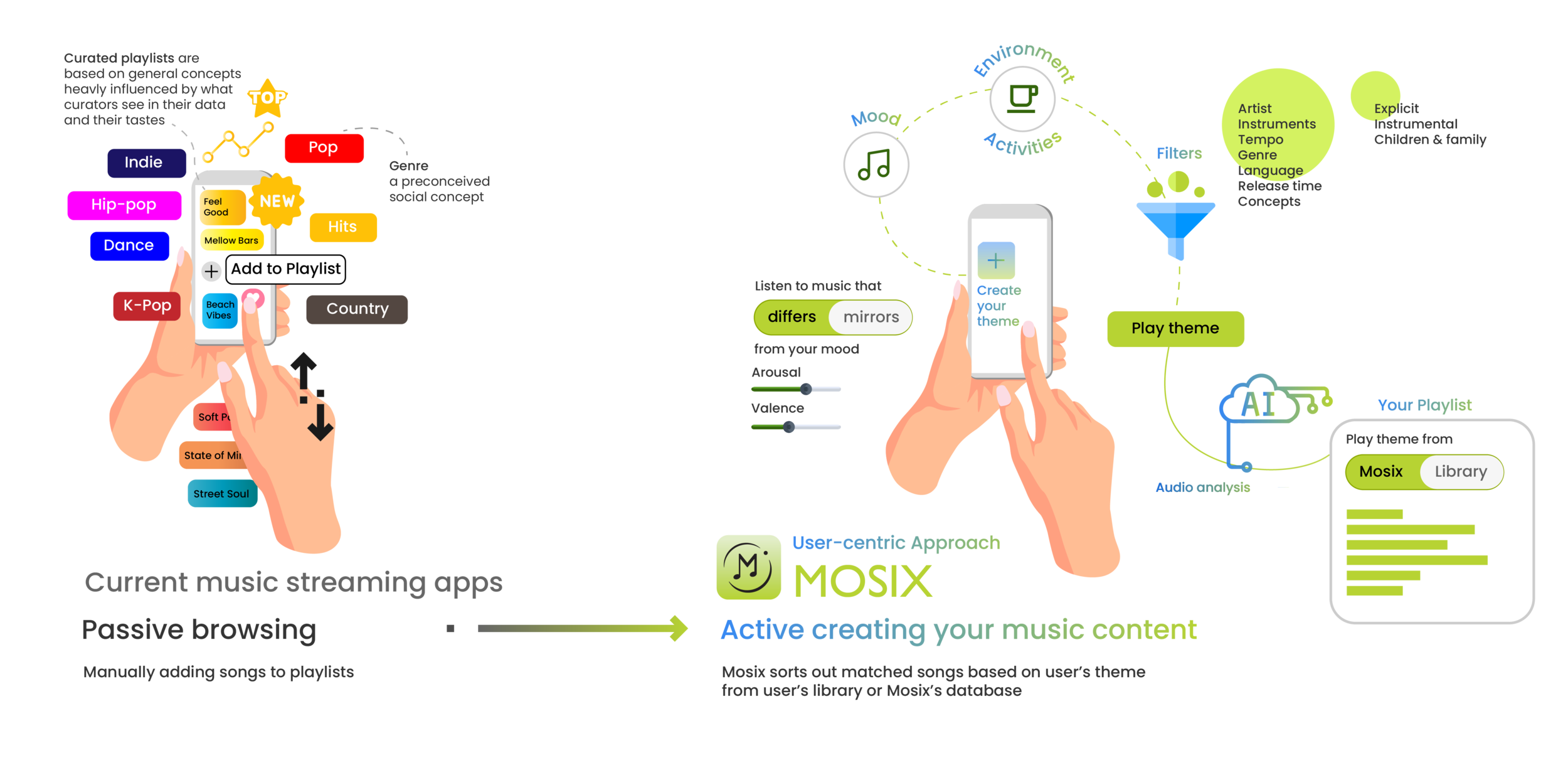
Mindmap
I started the exercise by asking What is music all about in modern times? With a mindmap, I broke down the answer to the question “what elements are composed of music?”
After doing desk research (journalism, news, competitors’ products, Youtube, Reddit) on topics of discovering music and music organization and from interviewing 2 music listeners(age 18-27), I listed down the problems, concerns, and background from people’s relationships with music streaming services. Interestingly, I found many similar patterns in their problems, so I synthesized these patterns into representing 4 types of persona.
Target Groups
Music Explorer, Music Enthusiast, Casual Listener, Person Coping with Digital Anxiety
💡 Findings
Having too many categories to choose from often obstructs our decision-making. (Hick’s Law)
Many users say they’ve given up trying to sort their music any further than a “master playlist” because it’s too overly complicated to sort into multiples attributes. This causes the tendency for the user to listen to a song over and over again, listen mostly to recent/similar music, passively browse “curated playlists”, or randomly shuffle in a big library of music.
Users want personalized content based on activities, moods, music tastes with an easy, effective music system
None of the users stick to genres
Users like to listen to similar artists but also signal that they would like to explore out of their music familiarity
Users are very open to music variety. However, they say they know when they dislike a song but can’t explain exactly why
Curated playlist, which is based on a general concept, similar genre, or similar artist, is a hit or miss for users
User Journey
2. Define Goals and Requirements
Mosix aims to provide a music service through an AI song-recommendation algorithm, which user creates theme-based playlists based on users’ inputs (mood, environment)
Clients Goals
Bring the best personalized music experience
Deliver high-quality music streaming at a competitive price
Increase user retention & user sign-up
Create a music discovering system that helps underrate artists to be noticed.
Expand the horizon of music extracted from audio/musical context, not simply from social context.
App Functions
Create/play a theme-based playlist based on moods, environments, and activities, etc
Simplifies the music discovering/listening system that changes the user’s behavior from passive browsing to active creating the personalized music content the user wants.
Increase the user’s awareness of their emotions/moods by
providing a place where users can reflect on their music experience
Discover unfamiliar music and forgotten music through theme-based playlists
3. Design
Content Map
Sitemap
Wireframe



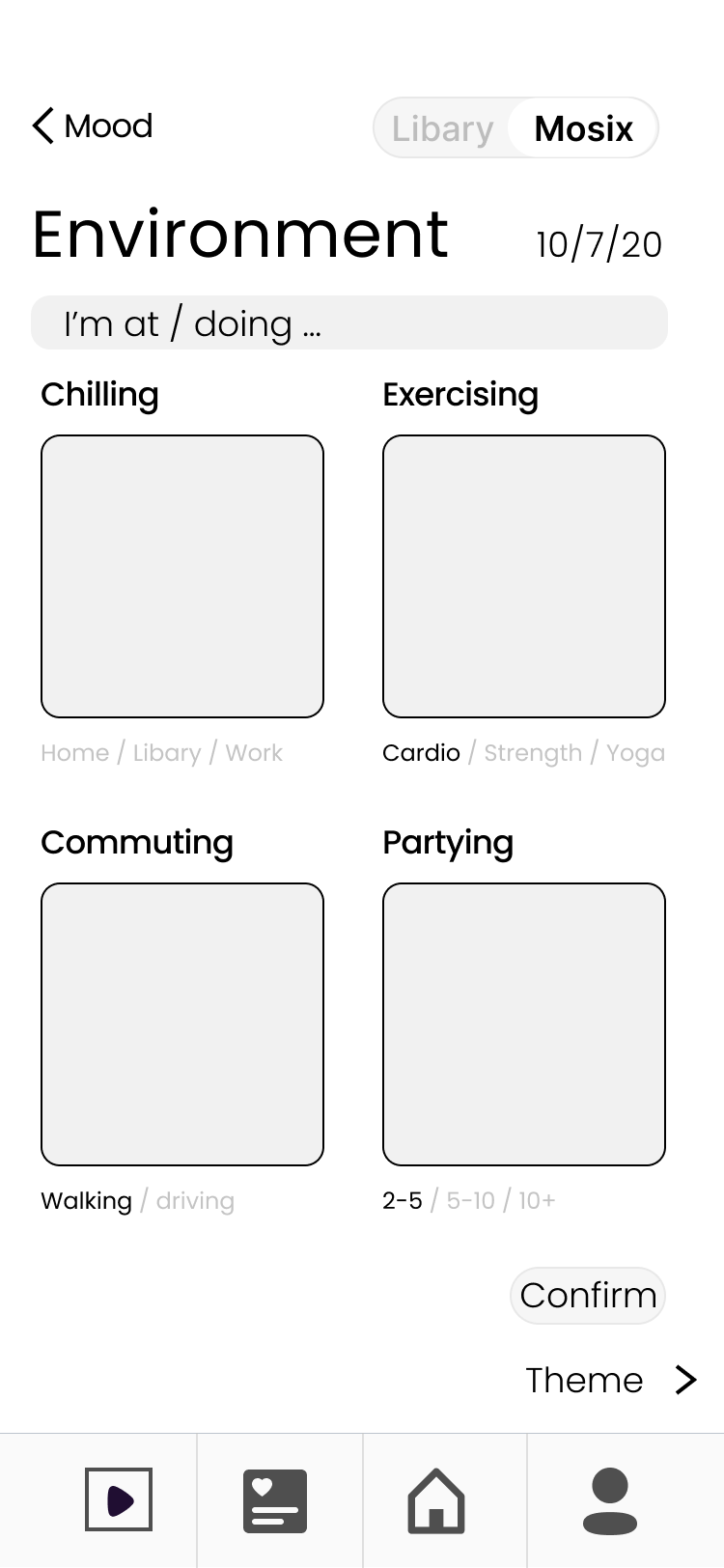
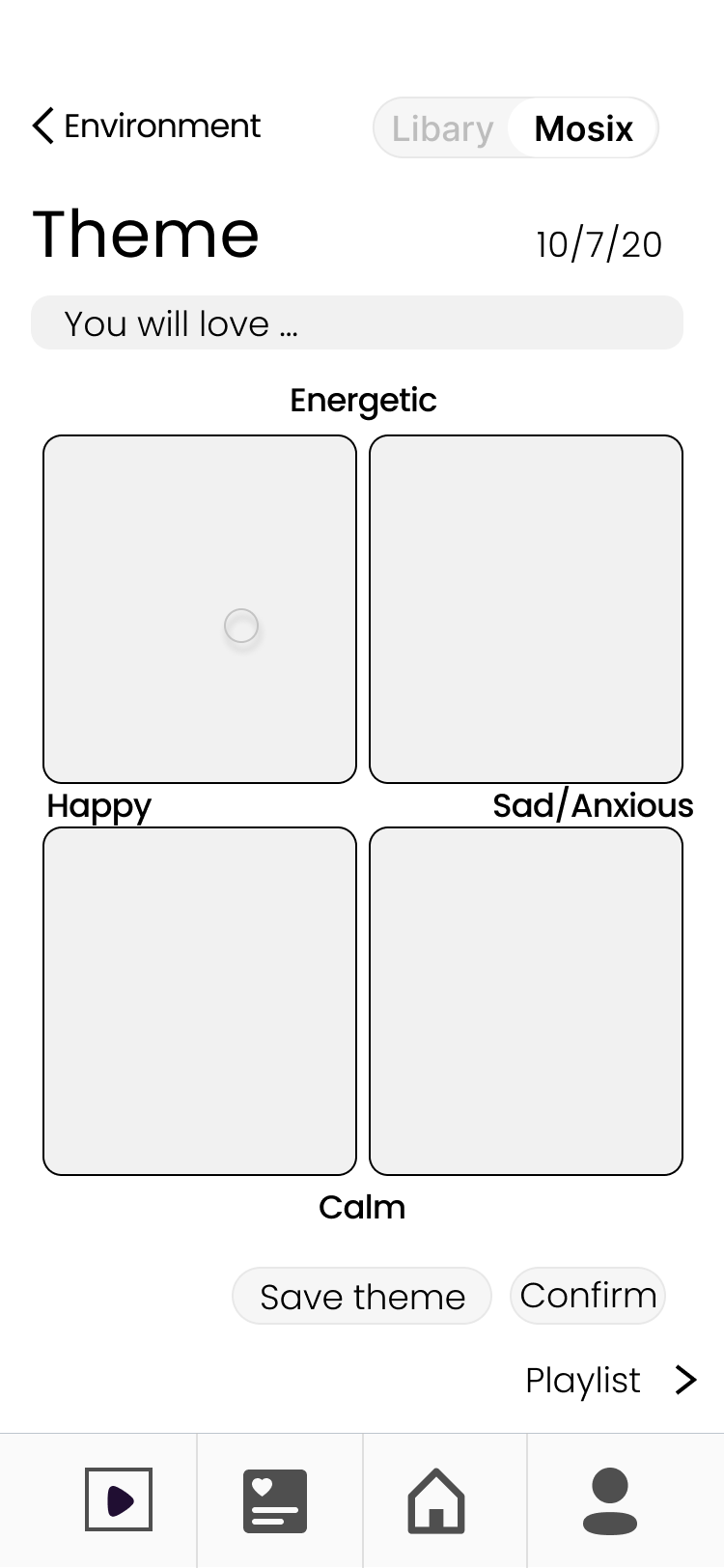

4. Evaluate
Usability Testing
To evaluate my app, I tested my clickable prototype on 3 users, all of which use music streaming services on a weekly basis.
I took notes while they walked me through my app with a combination of specific tasks and open questions
Goals for improving my design
Clarifying the UX writing and IA
Streamline the process of creating a theme, remove the 4 blocks design of category
Further develop the music journal function
5. Revise the design
Information Architecture
Refined the process of creating a theme with 3 steps - identify, experience, reflection
Added features like highlight a song, set a timer for music sessions for the music reflection feature
Wireframe Sketches
I studied the UI on Spotify, Apple Music, and Headspace, and took those as my inspiration. Based on the comments from the usability testing and new IA, I quickly ideated and sketched the wireframes to create high-fidelity mockups.
Based on feedbacks from usability testings from the same 3 testers and reviews from my product design mentors.
6. Final design
High Fidelity Prototype
🪄 Create a theme
🎵 Music player
Results
An effective music recommendation is to give a personalized experience that responds to the user’s needs
AI-recommended playlists created by the user's theme responds to the user's needs (mood, environment, etc.),
📉 Reduce the large effort spent on changing songs and searching for the right songs
📉 Reduce the need to manually create their personalized playlist
✔️ Simplify the music discovery system
🔎 Sort out theme-matched songs in the user’s music library when playing a theme
💎 Let the user discover unfamiliar music that matches with the user's theme
A music platform that can improve the user's mindfulness is very useful
📓 Features like creating music journals, timed music sessions, highlighting songs give spaces for reflection for the user
Modern UI makes the experience more delightful
Aesthetic-Usability Effect
Possible technical & design challenges
To make this a competitive product, the algorithm must be up to a high level of maturity as that's the core of the product.
For example, in the NLP model, labeling songs with adjectives might be limited to actually associate with the right moods
It’s hard to be precise about mood as it’s not easy for people to even describe their emotions, which can be unclear and can change easily.
I received several feedbacks about concerns for music licenses, which I can see that being a difficult issue in the real world.
Another concern was about the “differs/mirrors” feature, in which users said not sure how AI could suggest the mood of music if your mood is neutral and it wouldn’t make sense if you are happy and differs your mood to sad
Takeaway
For UI, a good way to be inspired is to study design systems from similar apps and know why their UI is good
Getting feedback early from different people will make your design process faster as you would fix problems before the final design
If I have more time, I hope to develop further on the music journal feature. I hope to consider more on edge cases and accessibility, as well as adding a social aspect.
Final Note
Designing for a digital experience involving moods will require deep research on the cognitive science of users. In this, I expanded my knowledge on machine learning and how recommendation algorithm works as well as designing for wellness.
Overall, the purpose of my design is to propose an opportunity for a personalized experience of discovering and listening to music.
Thank you for reading all the way to the end!
Why not check out the branding behind the music app?
References
“Genre was once a practical tool for organizing record shops and programming radio stations, but it seems unlikely to remain one in an era in which all music feels like a hybrid, and listeners are no longer encouraged (or incentivized) to choose a single area of interest.” – The New Yorker, Genre is Disappearing, What Comes Next









